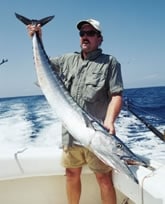
| Hefty ‘hoo such as this can be taken on swimming plugs, but live bait – specifically blue runners – often works best. |
The winter run of wahoo off Texas couldn’t come at a better time. Just when many offshore game fish in the Gulf are migrating away from the coast, wahoo are turning it on, providing excellent angling opportunities from November through February.
During late fall and early winter, boats out of Galveston and Freeport have ready access to this fishery, which takes place anywhere from 70 to 110 miles offshore. Three of the best areas to target wahoo out of these ports are the East and West Flower Gardens and Stetson Bank. These three hot spots encompass 42 square miles of water and attract lots of wahoo each winter. Knowledgeable anglers who fish this area typically troll a spread of diving plugs that imitate a favorite food of wahoo – blue runners.
As winter progresses, prime fishing shifts to the lower Texas coast, where ports such as Port Aransas shine during January and February. In this area, the best strategy involves trolling live baits or lures around the rigs located from 35 to 45 miles offshore, in 250 to 300 feet of water.
Obviously, the big difference between fishing the banks off the upper Texas coast and fishing the rigs out of Port Aransas is distance. The banks require a pretty good run, up to 110 miles, while the rigs are less than half that distance.
Banking on ‘Hoo
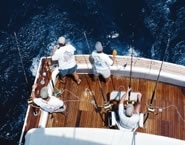
Boats out of Galveston and Freeport make the most of the wahoo bite by running to hot spots such as the Flower Gardens and offshore rigs.|
The draw for wahoo at the Flower Gardens and Stetson Bank is the rapid depth change and upwellings that occur along the edge of the banks. For example, the East Flower Gardens rise to within 60 feet of the surface. Along the edge, the depth drops to 220 feet. The West Flower Gardens rise to within 66 feet of the surface and drop off into 250 feet of water. At Stetson Bank the bottom rises to within 53 feet of the surface from a depth of 200 feet.
This type of dramatic bottom structure attracts big schools of baitfish, which in turn are preyed upon by wahoo. Making a run to the Gardens and Stetson Bank is a long haul, to be sure, but it’s definitely worth the effort if you like to troll for one of the most aggressive and fastest fish in the Gulf. We’re talking about wahoo from 30 to 100 pounds.
There’s no shortage of hot spots around the Gardens and Stetson. The West Flower Gardens cover 22.5 square miles, with 100 acres of reef crest. It is an oblong bank that measures 6.8 miles by five miles. The East Flower Gardens cover 19.2 square miles, with a reef crest of 250 acres. It’s a pear-shaped rise with a 3.1-mile diameter. Stetson Bank is spread out over one square nautical mile, with a reef crest of 35 acres.
Bill Platt, a Galveston-based charter captain, says the wahoo bite at the Gardens and Stetson picks up in November as the water temperature drops with the passage of the first cold fronts. “The banks off Galveston are the places to find wahoo in November and December,” he says. “It’s a pretty good haul out there. I run a 36-foot Contender with triple 300-horsepower Yamahas, so the run out in decent seas is not all that bad.
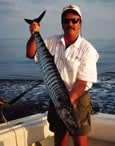
|
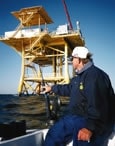
| |(left) The wahoo’s missile-shaped body is built for speed, while its teeth are made for slicing. If one bites off the tail of your bait, free-spool the remains and you might get bit again. (right) Wahoo action off the lower Texas coast primarily takes place around the offshore rigs, which hold plenty of ‘hoo food.|
“In late winter, the floater rigs 110 to 125 miles offshore hold some huge wahoo. Again, that’s where a fast boat comes into play. The depth around those rigs ranges from 1,000 to 1,500 feet. And the water temperature is usually a little warmer, too. In November and December it runs from 72 to 75 degrees at the Gardens.”
Platt’s favorite technique is to troll a four-line spread consisting of two big Rapalas and two Marauders. “My favorite is the 10 1/2-inch, 4 1/2-ounce Rapala,” says Platt. “It’s a big lure that gets the attention of big wahoo. My favorite pattern is firetiger. It has produced a lot of wahoo. Good back-ups are orange-and-black, green mackerel and blue mackerel. Basically, you want a bait that vibrates and has lots of flash.”
The Marauder is great baitfish imitation that looks a lot like a blue runner, a favorite food of wahoo. The Marauders weigh ten ounces and emit lots of fish-attracting vibrations. Top patterns are blue-and-white, black-and-purple and dorado.
Try Different Lures, Colors
When seas are calm, Platt often pulls jetheads at high speeds around the rigs. In rough water, a chugger or plunger type lure is best. The C&H; Lil’ Stubby chugger is a proven killer on wahoo. “On slow days, don’t hesitate to change colors,” advises Platt. “If you catch two or three ‘hoo on one color, that’s a definite pattern. I think the water clarity, cloud cover and sunlight has a lot to do with which color happens to be good on any given day.”
Platt usually trolls his spread of four lures at six to nine knots, but says that bumping up the speed can draw more strikes. He fishes two Rapalas off the outriggers and two Marauders off the flat lines. The Rapalas are positioned 40 to 50 yards behind the transom; the Marauders 15 to 30 yards back. Platt says it’s important to keep at least one lure running just behind the prop wash, about 15 yards back. He has caught some of his heaviest ‘hoo on lures fished in this position.
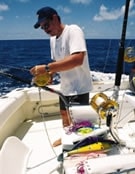
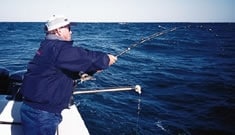
(top) High-speed trolling lures and teasers are great for covering a large area when the wahoo are scattered. (bottom) Some anglers score well by fishing live hardtails off a downrigger around weed lines, rigs and bottom structure.|
Platt’s top trolling rods are American Rod Smiths from 5 1/2 to six feet long. They are matched with 30- to 50-wide reels. The 30-wides are spooled with 40-pound Sufix line, while the 50-wides carry 50- to 80-pound line. If he’s into big wahoo, fish in the 75- to 100-pound class, he uses the 50-wides. The main line is tied to a 200-pound-test, black swivel. The leader is six feet of 150-pound braided wire, and is crimped to the swivel and the lure.
As we head deeper into winter and the water temperature cools even more, the wahoo bite gathers momentum along the lower Texas coast.
Action off Aransas
Instead of fishing drops and making long runs offshore, anglers in this region head for the Southern and Baker oil and gas rigs. The Southern Rig is located 35 miles out; the Baker rigs are 45 miles out. The procedure is to troll lures or fish live baits around the rigs in 250 to 300 feet of water. These rigs are located near rock outcroppings, which serve as a big draw for baitfish and the wahoo that eat them.
The two Baker rigs are located just south of South Baker Rocks and North Baker Rocks. Water depth at the North Baker Rocks is 148 feet, dropping off to 224 feet. The South Baker Rocks rise to within 202 feet of the surface. The adjacent rigs lie in 325 feet of water. The rocks and rigs are about 45 miles out. The Big Southern Rocks are located just off the so-called Southern Rig. The rocks rise to within 219 feet of the surface. The Southern Rig lies in 275 to 318 feet of water, some 35 miles from the Aransas Pass jetties.
Captain Tommy Gueldner has been fishing the offshore waters out of Port Aransas for 29 years, and for the past 15 he has worked as a charter captain aboard the Yellowfin, a 40-foot sportfisherman. “Wahoo fishing begins to pick up in January and continues to improve through February,” says Gueldner. “The best locations are definitely the Southern and Baker Rigs. During January and February, the water temperature here ranges from 68 to 70 degrees. I don’t know what the draw for wahoo is around those particular rigs. They could be spawning. But one thing is for sure: the fishing for big ‘hoo is excellent. At that time of year we’ll be catching them in the 40- to 80-pound class. The heaviest fish I’ve caught around those rigs is a 106-pounder.”
Plugs and Ballyhoo
Gueldner usually trolls three diving lures and one or two rigged ballyhoo around the rigs. Another option is to pull two lures and two ballyhoo. His favorite lures are big Rapalas and Yo-Zuris that get down deep around the rigs. Top patterns are blue-and-white, green-and-white and blue-and-silver.
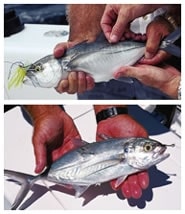
Blue runners are prime baits for wahoo. They can be bridled or rigged on a multi-hook setup, with one or more No. 4 trebles placed farther back in the bait’s body to foil short-strikers.|
“When I approach a rig, I look to see which way the current is running. This tells me where the baitfish such as menhaden and blue runners will be holding,” says Gueldner. “Most of the time the baitfish will show up on my depthfinder as a big red spot. They will usually be on the upcurrent side of the rig. Wherever you find the bait, that’s where the wahoo will most likely be feeding. If I can’t locate baitfish around the rig I’ll move away from the structure and troll in open water. That’s a good way to locate big wahoo.”
Gueldner likes to troll two ballyhoo long off the ‘riggers, two diving lures on the flat lines, and one diving lure down the middle. He prefers eight-inch ballyhoo, which he rigs on 9/0 long-shank, needle-eye hooks. To add color and protect the bait from washing out, he slides a hot-pink skirt down the leader and over the head of the bally. To make the bait run deeper, he sometimes rigs an egg sinker under the chin.
Gueldner fishes lures and ballyhoo off Shimano TLD 25s or Penn LD-16s loaded with 50-pound Sufix line and matched to Penn tuna sticks. The running line is attached to an eight-foot length of 100-pound stainless leader wire via a 50-pound-test, ball-bearing swivel. A haywire twist is used to connect the wire to the swivel and the lure. Gueldner’s most productive trolling speed is seven to eight knots, but he’ll experiment with faster speeds if the bite is slow.
Regardless of where you are fishing for winter wahoo off the Texas coast, don’t ever underestimate the power of live baits. They’ll produce wahoo in the worst conditions. You can just about always catch blue runners around the platforms or mooring buoys on Sabiki rigs. Runners from 12 to 14 inches long are perfect.
To fish runners, first attach the running line to an 80-pound-test, black barrel swivel using a fisherman’s knot, then twist on a 100-pound-test wire leader. You can either use a single live-bait hook or a combination of hooks to rig blue runners. If you opt for a single hook, go with a 6/0 to 8/0, black live-bait hook.
| ### Texas Wahoo ChartersCapt. Bill Platt (Galveston), (409) 739-3489Capt. Tommy Gueldner (Port Aransas), (361) 749-6055 |
Hook placement is very important. The bait can be bridled, but the quickest rigging method is to run the hook through the soft spot on the runner’s head, then simply flip the bait overboard. Platt’s tandem-hook setup starts with a 4/0 Mustad Live Bait Ultra Point. Behind that he adds a No. 4 Mustad 4X Kingfish treble. The distance between the two hooks is about seven inches.
It’s usually best to fish just two live baits at a time to avoid tangles. Fish them either off the outriggers or the aft rod holders. Wahoo are usually aggressive, and there is no doubt when they eat one of your baits.
Weather Watch
The worst thing you can do when fishing for winter wahoo off the Texas coast is to throw caution to the wind. Remember, we are talking about fishing in late fall and winter. It’s the time when cold fronts plow their way across the Gulf, creating dangerous conditions. Always know what the weather is doing and play it safe. Wahoo may be awesome, but they’re not worth risking your life over!









